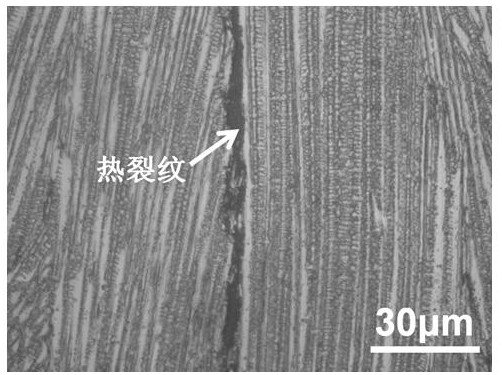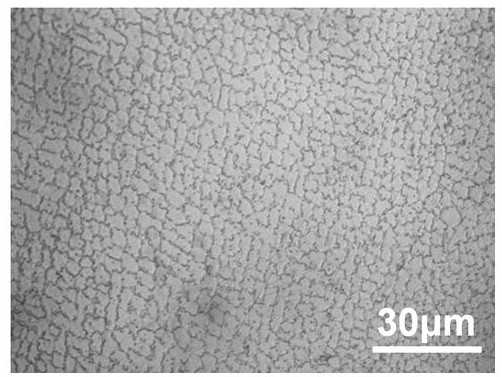A Method for Reducing Hot Cracking Sensitivity During Laser Additive Repair of Die Steel
A laser additive and mold steel technology, applied in additive processing, additive manufacturing, etc., can solve problems such as difficulty in guaranteeing the internal quality of laser additive repair, high temperature gradient of local molten pool, and performance degradation of repaired parts
- Summary
- Abstract
- Description
- Claims
- Application Information
AI Technical Summary
Problems solved by technology
Method used
Image
Examples
Embodiment 1
[0016] Take Cr12MoV steel as an example.
[0017] Step 1: First, polish, ultrasonically clean and dry the Cr12MoV mold repair area, and use electromagnetic induction heating equipment to preheat the substrate to 280°C;
[0018] Step 2: Use a thermal imager to monitor the molten pool during the laser additive manufacturing process, obtain the surface temperature information of the molten pool, and calculate the average temperature gradient G and cooling rate ξ at the boundary of the molten pool;
[0019] Step 3: According to 5.5×10 3 °C / m≤G≤1.5×10 5 ℃ / m, and 5.5×10 3 ℃ / s≤ξ≤1.5×10 5 ℃ / s principle to optimize the process parameters;
[0020] Step 4: The optimized process window obtained is as follows: the laser power is 1550W, the scanning speed is 16mm / s, the spot diameter is 4.0mm, the powder feeding amount is 27.5g / min, the overlapping amount is 50%, and the height direction increment Z is 0.30 mm / layer; the repair powder material is a mixed powder of Cr12MoV die steel, p...
Embodiment 2
[0025] Take H13 steel as an example.
[0026] Step 1: First, polish, ultrasonically clean and dry the repaired area of the H13 steel mold, and use electromagnetic induction heating equipment to preheat the base material to 280°C;
[0027] Step 2: Use a thermal imager to monitor the molten pool during the laser additive manufacturing process, obtain the surface temperature information of the molten pool, and calculate the average temperature gradient G and cooling rate ξ at the boundary of the molten pool;
[0028] Step 3: According to 5.5×10 3 °C / m≤G≤1.5×10 5 ℃ / m, and 5.5×10 3 ℃ / s≤ξ≤1.5×10 5 ℃ / s principle to optimize the process parameters;
[0029] Step 4: The optimized process window obtained is as follows: the laser power is 1500W, the scanning speed is 15mm / s, the spot diameter is 4.0mm, the powder feeding amount is 30g / min, the overlapping amount is 50%, and the height direction increment Z is 0.30mm / layer; the repair powder material is a mixed powder of H13 die ...
PUM
 Login to View More
Login to View More Abstract
Description
Claims
Application Information
 Login to View More
Login to View More - R&D
- Intellectual Property
- Life Sciences
- Materials
- Tech Scout
- Unparalleled Data Quality
- Higher Quality Content
- 60% Fewer Hallucinations
Browse by: Latest US Patents, China's latest patents, Technical Efficacy Thesaurus, Application Domain, Technology Topic, Popular Technical Reports.
© 2025 PatSnap. All rights reserved.Legal|Privacy policy|Modern Slavery Act Transparency Statement|Sitemap|About US| Contact US: help@patsnap.com


